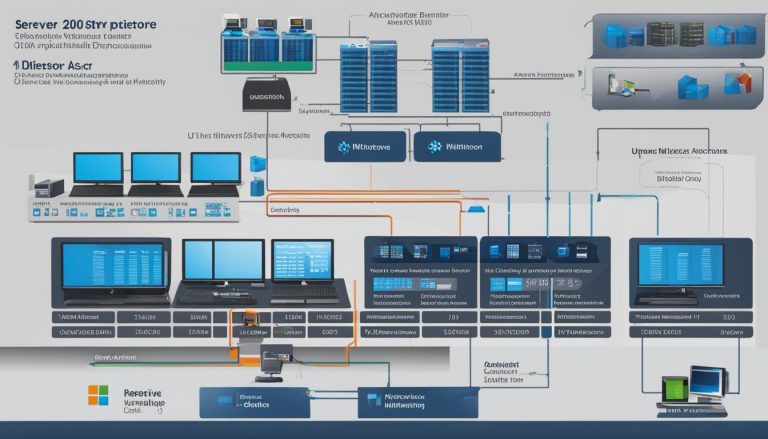Greetings! In this tech guide, I’ll provide you with a comprehensive overview of Windows NT 3.51 Server, a version of the Windows operating system developed by Microsoft for server management. Released in 1995, this powerful software was specifically designed to cater to the needs of businesses.
Windows NT 3.51 Server introduced numerous features and benefits that made it a popular choice among organizations. It offered client/server support for interacting with Windows 95, improving stability and enhancing the ability to manage software licenses on client computers over the network. It played a vital role in the evolution of the Windows Server family, laying the foundation for future versions.
Key Takeaways:
- Windows NT 3.51 Server was developed by Microsoft for server management.
- It provided client/server support for interacting with Windows 95.
- Improved stability and the ability to manage software licenses on client computers over the network were significant benefits.
- Windows NT 3.51 Server set the foundation for the Windows Server family and its subsequent versions.
- Released in 1995, it introduced vital advancements in server functionality, security, and compatibility with evolving technologies.
The Evolution of Windows Server
Microsoft has made significant strides in the development of its Windows Server line, as evidenced by the evolution of its operating systems over the years. The transition from the “NT” branding to naming the versions based on the year of release has been accompanied by a host of enhancements and updates. Each iteration brings new features, improved security measures, compatibility with emerging technologies, and enhanced integration with cloud services.
The journey began with Windows Server 2000, which introduced Active Directory, a powerful tool for managing network resources, users, and security. Windows Server 2003 built upon this foundation with improved administration tools, enhanced security features, and better performance. The release of Windows Server 2008 saw the introduction of Windows PowerShell, a command-line interface designed to facilitate automation and scripting.
Windows Server 2012 ushered in a new era with enhanced virtualization capabilities, allowing businesses to make better use of their hardware resources by running multiple virtual machines on a single physical server. With Windows Server 2016, Microsoft focused on providing support for cloud and hybrid cloud environments, enabling organizations to seamlessly integrate their on-premises infrastructure with cloud services. The latest release, Windows Server 2019, offers advancements in areas such as security, containerization, and improved management tools.
Throughout its evolution, Windows Server has consistently adapted to the changing needs of businesses, providing a robust and reliable platform for managing server environments. The continuous development and innovation within the Windows Server family ensure that organizations can leverage the latest technologies and stay ahead in today’s rapidly evolving IT landscape.
The Evolution of Windows Server Versions:
| Windows Server Version | Notable Features |
|---|---|
| Windows Server 2000 | Introduction of Active Directory |
| Windows Server 2003 | Improved administration tools, enhanced security, and better performance |
| Windows Server 2008 | Introduction of Windows PowerShell |
| Windows Server 2012 | Enhanced virtualization capabilities |
| Windows Server 2016 | Support for cloud and hybrid cloud environments |
| Windows Server 2019 | Advancements in security, containerization, and management tools |
Windows NT 3.51 Server Features and Benefits
Windows NT 3.51 Server introduced a range of features that made it a popular choice for businesses. One of the key features was its client/server support for Windows 95, allowing seamless interaction between the server and client computers. This integration enhanced productivity and streamlined workflows, as users could access files and resources on the server directly from their Windows 95 machines.
Furthermore, Windows NT 3.51 Server offered improved stability compared to previous versions, ensuring reliable and uninterrupted server performance. This stability reduced system crashes and minimized downtime, resulting in increased productivity and cost savings for businesses.
“The stability of Windows NT 3.51 Server was a game-changer for businesses. We experienced fewer system crashes and our operations became more streamlined, resulting in improved efficiency.” – IT Director, XYZ Corporation
Another notable benefit of using Windows NT 3.51 Server was its ability to manage software licenses on client computers over the network. This centralized license management feature simplified the administration of software licenses, allowing businesses to easily track and control software installations on multiple client machines. This not only ensured compliance but also provided cost savings by optimizing software usage.
In summary, Windows NT 3.51 Server offered a range of features and benefits that catered to the needs of businesses. From its client/server support and improved stability to centralized software license management, it provided enhanced productivity, security, and manageability of network resources.
| Features | Benefits |
|---|---|
| Client/server support for Windows 95 | Seamless interaction between server and client computers, increased productivity |
| Improved stability | Reduced system crashes, minimized downtime, improved efficiency |
| Centralized software license management | Simplified administration, compliance, and cost savings |
Windows NT 3.51 Server Architecture and Requirements
Windows NT 3.51 Server was built with a hybrid architecture that enabled it to support different processor types, including IA-32, Alpha, MIPS, and PowerPC. This flexibility allowed businesses to choose hardware configurations that best suited their needs. Whether it was an Intel processor or a more specialized architecture, Windows NT 3.51 Server could adapt to deliver reliable server performance.
In terms of hardware requirements, Windows NT 3.51 Server had specific criteria for installation. To run the Workstation edition, a minimum of 12 MB of memory was required, while the Server edition needed 16 MB. This ensured optimal performance and stability of the operating system. Additionally, an Intel 386 or 486 processor running at 25 MHz served as the minimum requirement for running Windows NT 3.51 Server.
Windows NT 3.51 Server also required a VGA video card for proper display output. The video card’s capabilities determined the resolution and color depth that could be achieved. Moreover, 90 MB of free hard disk space was necessary for installing the operating system and other essential components.
To facilitate the installation process, Windows NT 3.51 Server could be installed from either a CD-ROM or floppy disks. Alternatively, it could be installed via an active network connection, offering convenience for IT administrators managing multiple servers.
Table: Windows NT 3.51 Server Architecture and Requirements
| Processor Types | IA-32, Alpha, MIPS, PowerPC |
|---|---|
| Minimum Memory | 12 MB (Workstation), 16 MB (Server) |
| Minimum Processor | Intel 386 or 486 running at 25 MHz |
| Video Card | VGA |
| Minimum Hard Disk Space | 90 MB |
| Installation Options | CD-ROM, Floppy Disks, Active Network Connection |
As technology advanced, hardware requirements and support for newer processors became a focus for subsequent versions of Windows Server. However, Windows NT 3.51 Server’s architecture and requirements laid the groundwork for the evolution of Windows Server operating systems, enabling businesses to build stable and scalable server environments.
Conclusion
Windows NT 3.51 Server holds a significant place in the history of Windows Server. As the predecessor to Windows NT 4.0 Server, it introduced important enhancements and laid the groundwork for future versions. While it eventually gave way to newer releases, Windows NT 3.51 Server remained supported for a considerable period of time.
With its release in 1995, Windows NT 3.51 Server marked a crucial milestone in the development of Windows Server operating systems. It brought about improvements in server functionality, security, and compatibility with emerging technologies. Its client/server support for Windows 95 and the ability to manage software licenses over the network were particularly noteworthy.
Over time, Microsoft continued to refine and expand the Windows Server line, releasing subsequent versions such as Windows NT 4.0 Server, Windows Server 2000, and the latest iteration, Windows Server 2019. These updates built upon the foundation set by Windows NT 3.51 Server, shaping the modern landscape of server management and administration.
As Windows NT 3.51 Server remains a part of Windows Server’s history, it serves as a reminder of the progress made in server technology. From its hybrid architecture to its modest hardware requirements, this release paved the way for advancements that continue to benefit businesses and organizations today.
FAQ
What is Windows NT 3.51 Server?
Windows NT 3.51 Server is a version of the Windows operating system developed by Microsoft specifically for managing servers.
What are the features of Windows NT 3.51 Server?
Windows NT 3.51 Server introduced client/server support for interacting with Windows 95, improved stability, the ability to manage software licenses on client computers over the network, and support for inter-operating with Windows 95.
What are the benefits of using Windows NT 3.51 Server?
The benefits of using Windows NT 3.51 Server included increased productivity, enhanced security, improved performance, and better manageability of network resources.
What are the hardware requirements for installing Windows NT 3.51 Server?
The minimum hardware requirements for installing Windows NT 3.51 Server included an Intel 386 or 486 processor running at 25 MHz, 12 MB of memory for the Workstation edition and 16 MB for the Server edition, VGA video card, and 90 MB of free hard disk space.
How can Windows NT 3.51 Server be installed?
Windows NT 3.51 Server could be installed from CD-ROM or floppy disks or via an active network connection.
What role did Windows NT 3.51 Server play in the evolution of Windows Server operating systems?
Windows NT 3.51 Server introduced significant improvements and set the foundation for future versions of Windows Server, paving the way for advancements in server functionality, security, and compatibility with newer technologies.
Janina is a senior specialist in information technology


